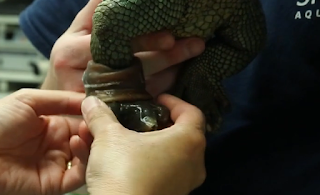
Bentley Yoder was never expected to survive. His mother, Sierra Yoder of Sugarcreek, Ohio, was well aware, when she went into labor on Halloween night 2015, that she would likely only get to hold her son for a few minutes before he passed away.
She had known since the 22nd week of her pregnancy, when she went in for her normal ultrasound, and the doctor told her that something was very, very wrong. Something was wrong with the baby’s head, he told Sierra and her husband, Dustin, and sent them to a hospital for further tests.
Neurosurgeons at the Canton hospital told the couple that their baby had a rare congenital condition called encephalocele, meaning that a portion of his brain was growing outside of his skull.
About 375 babies, or one in 10,000, are born with the condition each year, according to the Centers for Disease Control and Prevention, and while there are varying degrees of severity, the disease, needless to say, causes serious difficulties for children suffering from it: developmental delays, vision problems, seizures, and more. Bentley’s case fell into the severe category, meaning that he had a very slim chance of surviving long after his birth. Even if he did live, doctors said, he wouldn’t have any cognitive function.
The Yoders were encouraged to think about abortion, and they agreed to terminate the pregnancy, not wanting their child to suffer when there was no hope of recovery. The night before the scheduled procedure, however, Sierra realized she couldn’t go through with it. She and Dustin agreed on a name for the baby – Bentley Ross Yoder – and doctors gave them brochures for funeral homes in the area.
Nine hours after she went into labor on Halloween night, Bentley was born. His condition was immediately clear from the massive protrusion at the back of his head, but to his parents, he was perfect
36 hours later, however, family members were still holding the baby and passing him around. The doctors, unsure of how much longer Bentley would live, told his parents to take him home and arrange hospice care, which they did. Four weeks later, they took him to a specialist at Nationwide Children’s Hospital in Columbus. The specialist took some MRIs and told the Yoders that Bentley’s brain was too damaged for him to survive much longer.
Four months later, the couple took Bentley to the Cleveland Clinic. For the first time, a surgeon gave them a sliver of hope – Bentley was using his brain, which had been already clear to Sierra and Dustin. Their baby, who doctors had said was going to be born a “shell,” unlikely to ever move or even breathe, was acting just like a normal baby – indistinguishable from their first son, Beau, other than the protrusion on his head, according to Sierra. The surgeon told them it was possible that Bentley’s brain could be placed inside his skull, though she didn’t know if he could survive the surgery..
The Yoders were referred to Boston Children’s Hospital, where they met with chief plastic surgeon Dr. John Meara and neurosurgeon Dr. Mark Proctor, who had plenty of experience with cranial deformities – and with 3D printing. The two surgeons were part of a team that reshaped the skull of a baby named Violet in 2014, in a surgery that was carefully pre-planned using 3D printed models. Drs. Meara and Proctor took the same approach with Bentley’s case, 3D printing models of his cranium and planning the delicate procedure that would allow his brain to be encased within his skull.
According to Dr. Meara, Bentley had 100 cubic centimeters of brain outside of his skull – a significant amount that would require his cranium to be expanded for the tissue to fit inside. Using the 3D printed models, he and Dr. Proctor devised a plan to make several vertical slices in the cranium and insert biocompatible, dissolving plates to hold it open. The protruding part of Bentley’s brain – the portion that controls vision, motor function and problem-solving, would slip inside where it belonged.
yoder On May 24, 2016, Bentley went into surgery. The surgeons drained excess cerebrospinal fluid from his brain, made the cuts in his cranium, and gently eased his brain inside. Then they closed the gap using leftover bone from the cuts. Five hours later, Sierra, Dustin and Bentley’s brother Beau went to see him in the recovery room.

The delicate mass at the back of his head was gone, and now, a month later, his blond curls are growing back in. He’s also holding his head up, eating, smiling and chattering like any seven-month-old. It’s uncertain what life will be like for him as he grows up, but he will grow up, and the doctors told Sierra that they believe he will have a “rewarding life,” despite any challenges or complications may arise.
Using 3D printing to successfully operate on a condition as severe as Bentley’s is a new phenomenon, and therefore lacks precedence to give doctors a clear idea of what lies ahead. Bentley himself has made it clear that he is a survivor, however, and Sierra said that a part of her always knew that Bentley was going to defy expectations. That’s why she decided not to end the pregnancy.
Contributed by 3Dprint





























